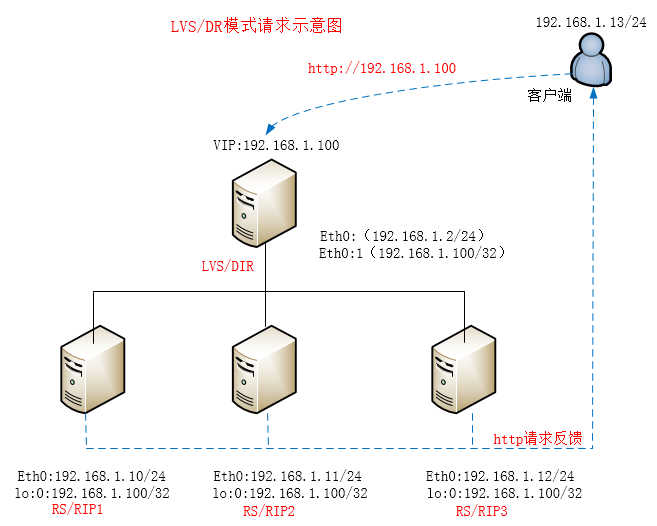上一节我们讲到了LVS/NAT模式实例部署,这节将会讲到LVS/DR实例部署,LVS/DR模式也是日常企业中比较常用的一种模式,下面我们来讲讲LVS/DR部署过程
LVS/NAT实例部署
如图所示为整体的拓扑图:

一.部署前说明:
(1)系统版本: centos 6.6
(2)角色及ip相关信息:
CIP:192.168.1.13/24
VIP:192.168.1.100/24
DIR:eth0:192.168.1.2/24
Real-server:192.168.1.10/24 和 192.168.1.11/24. 192.168.1.12/24(提供http服务)
二.部署操作:
负载均衡器上配置操作
(1)在DIR上安装ipvsadm软件包以及相关依赖包:
# yum install popt-devel libnl-devel ipvsadm -y
(2)在DIR上新建一个shell脚本文件,如下操作所示:
# vim /etc/init.d/lvs-dr
脚本内容如下
#!/bin/sh
#
# Startup script handle the initialisation of LVS
# chkconfig: - 28 72
# description: Initialise the Linux Virtual Server for DR
#
### BEGIN INIT INFO
# Provides: ipvsadm
# Required-Start: $local_fs $network $named
# Required-Stop: $local_fs $remote_fs $network
# Short-Description: Initialise the Linux Virtual Server
# Description: The Linux Virtual Server is a highly scalable and highly
# available server built on a cluster of real servers, with the load
# balancer running on Linux.
# description: start LVS of DR
LOCK=/var/lock/ipvsadm.lock
VIP=192.168.1.100
RIP1=192.168.1.10
RIP2=192.168.1.11
RIP3=192.168.1.12
. /etc/rc.d/init.d/functions
start() {
if [ -e $LOCK ];
then
echo "The LVS-DR Server is already running !"
else
#Set the Virtual IP Address
/sbin/ifconfig eth0:1 $VIP broadcast $VIP netmask 255.255.255.255 up
/sbin/route add -host $VIP dev eth0:1
#Clear IPVS Table
/sbin/ipvsadm -C
#Set Lvs
/sbin/ipvsadm -At $VIP:80 -s rr
/sbin/ipvsadm -at $VIP:80 -r $RIP1:80 -g -w 1
/sbin/ipvsadm -at $VIP:80 -r $RIP2:80 -g -w 1
/sbin/ipvsadm -at $VIP:80 -r $RIP3:80 -g -w 1
/bin/touch $LOCK
#Run Lvs
echo "starting LVS-DR Server is ok !"
fi
}
stop() {
/sbin/ipvsadm -C
/sbin/ifconfig eth0:1 down >/dev/null
/sbin/route del -host $VIP dev eth0:1
rm -rf $LOCK
echo "stopping LVS-DR server is ok !"
}
status() {
if [ -e $LOCK ];
then
echo "The LVS-DR Server is already running !"
else
echo "The LVS-DR Server is not running !"
fi
}
case "$1" in
start)
start
;;
stop)
stop
;;
restart)
stop
start
;;
status)
status
;;
*)
echo "Usage: $1 {start|stop|restart|status}"
exit 1
esac
exit 0# chmod 777 /etc/init.d/lvs-dr
# service lvd-dr start
RS server 上配置操作
(1)分别在每个RIP(RIP1,RIP2,RIP3)上新建一个shell脚本文件,如下操作所示:
# vim /etc/init.d/lvs-dr
脚本内容如下
#!/bin/sh
#
# Startup script handle the initialisation of LVS
# chkconfig: - 28 72
# description: Initialise the Linux Virtual Server for NAT
#
### BEGIN INIT INFO
# Provides: ipvsadm
# Required-Start: $local_fs $network $named
# Required-Stop: $local_fs $remote_fs $network
# Short-Description: Initialise the Linux Virtual Server
# Description: The Linux Virtual Server is a highly scalable and highly
# available server built on a cluster of real servers, with the load
# balancer running on Linux.
# description: start LVS of DR-RIP
LOCK=/var/lock/ipvsadm.lock
VIP=192.168.10.100
. /etc/rc.d/init.d/functions
start() {
if [ -e $LOCK ];
then
echo "The LVS-DR-RIP Server is already running !"
else
/sbin/ifconfig lo:0 $VIP netmask 255.255.255.255 broadcast $VIP up
/sbin/route add -host $VIP dev lo:0
echo "1" >/proc/sys/net/ipv4/conf/lo/arp_ignore
echo "2" >/proc/sys/net/ipv4/conf/lo/arp_announce
echo "1" >/proc/sys/net/ipv4/conf/all/arp_ignore
echo "2" >/proc/sys/net/ipv4/conf/all/arp_announce
/bin/touch $LOCK
echo "starting LVS-DR-RIP server is ok !"
fi
}
stop() {
/sbin/ifconfig lo:0 down
echo "0" >/proc/sys/net/ipv4/conf/lo/arp_ignore
echo "0" >/proc/sys/net/ipv4/conf/lo/arp_announce
echo "0" >/proc/sys/net/ipv4/conf/all/arp_ignore
echo "0" >/proc/sys/net/ipv4/conf/all/arp_announce
rm -rf $LOCK
echo "stopping LVS-DR-RIP server is ok !"
}
status() {
if [ -e $LOCK ];
then
echo "The LVS-DR-RIP Server is already running !"
else
echo "The LVS-DR-RIP Server is not running !"
fi
}
case "$1" in
start)
start
;;
stop)
stop
;;
restart)
stop
start
;;
status)
status
;;
*)
echo "Usage: $1 {start|stop|restart|status}"
exit 1
esac
exit 0授权并启动该脚本
# chmod 777 /etc/init.d/lvs-dr
# service lvd-dr start
(2)分别在每个RIP上安装http服务,并创建测试页,如下分别为RIP上测试页面:
RIP1上的测试页:
RIP2上的测试页:
RIP3上的测试页:
三.LVS负载测试:
在客户端上访问:http://vip,这时我们就可以看到如下的页面,此时页面为RIP1的页面
多次刷新页面会分别跳转到RIP2,RIP3上,如下:
这时我们用命令ipvsadm -Ln -c 可以看到如下链接信息:
原文:http://blief.blog.51cto.com/6170059/1747263